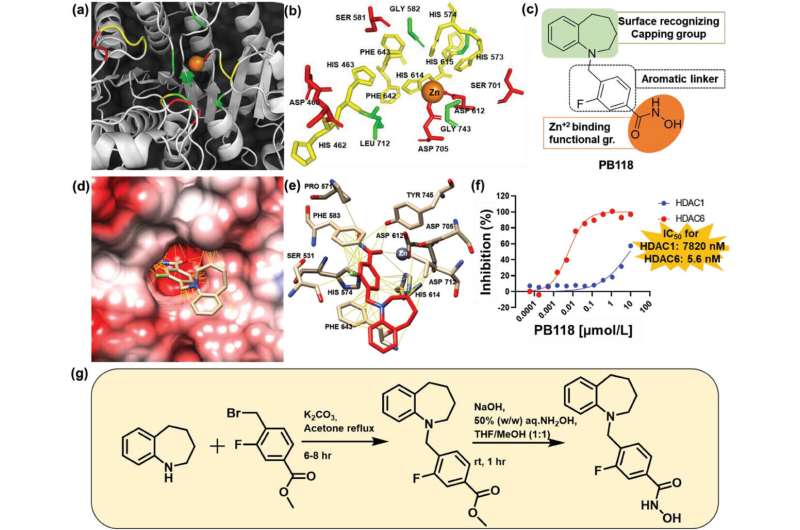Chemical properties, and synthesis of PB118. Credit: Advanced Science (2023). DOI: 10.1002/advs.202304545
In people with Alzheimer's disease (AD), the epigenetic regulator HDAC6 (histone deacetylase 6), which controls many biological processes, is significantly overexpressed in the brain.
Evidence suggests that HDAC6 is closely related to amyloid and tau pathology, the two primary hallmarks of AD.
But it has been unclear whether the amyloid deposits in AD change with elevation of HDAC6 expression as the disease progresses; or whether HDAC6 itself regulates neuroinflammation and other neuropathological changes in AD.
Researchers at Massachusetts General Hospital (MGH), a founding member of the Mass General Brigham health care system, recently used a series of chemical and biological studies in disease-specific cell lines to learn more about the role of HDAC6 in AD and how new therapeutics designed to inhibit its activity that could reduce pathology of the disease. The results of this work are published in Advanced Science.
"We continue to lack effective and safe treatments that can prevent, stop, or reverse AD progression largely due to the complex etiology of AD," said senior author Can (Martin) Zhang, MD, Ph.D., an investigator at the McCance Center for Brain Health at Massachusetts General Hospital. "Collective data suggest that we need new angles and alternative approaches."
Among the cellular functions that HDAC6 controls are cell proliferation, immune response, stress response, neurological changes, and clearance of misfolded proteins.
When HDAC6 is dysfunctional, abnormal cellular responses result, leading to pathology. HDAC6 has been implicated in multiple diseases, including cancer and neurodegenerative diseases. Currently, drugs that inhibit HDAC6 are being evaluated in clinical trials for the treatment of cancer, for example.
The role of HDAC6 in the neurodegeneration of AD, as well as that of other epigenetic proteins, is less well explored, however.
To address this, the investigators sought to analyze the effects of the harmful accumulation of HDAC6 in the brain of a mouse model of AD and looked at how HDAC6 changed as the disease pathology started to progress in early stages.
"In this work, we have seen both amyloid deposits and HDAC6 levels become elevated in mouse models of AD as the mice age, suggesting both factors may combine to impair the clearance of amyloid beta (Aβ) from the brain and contribute to the damaging effects of the disease," said lead author Prasenjit Mondal, Ph.D., senior postdoctoral research fellow at Massachusetts General Hospital.
The investigators found that their HDAC6 inhibitor, called PB118, cleared amyloid-beta deposits through several mechanisms, including reducing Aβ production, increasing the uptake of Aβ from the brain, improving the tubulin/microtubule network disrupted in AD, regulating different cytokines and chemokines responsible for inflammation, and significantly reducing tau phosphorylation associated with AD.
In ongoing research, the investigators are developing an inhibitor molecule that binds strongly and exclusively to HDAC6 and not to additional proteins. They are also studying whether the inhibitors have the potential to suppress the neuropathological changes of Alzheimer's disease in mice.
In addition, the research team has developed a new positron emission tomography (PET) imaging probe that can detect increased HDAC6 levels in the brain to potentially serve as an imaging biomarker of AD.
More information: Prasenjit Mondal et al, Structure‐Based Discovery of A Small Molecule Inhibitor of Histone Deacetylase 6 (HDAC6) that Significantly Reduces Alzheimer's Disease Neuropathology, Advanced Science (2023). DOI: 10.1002/advs.202304545
Journal information: Advanced Science
Provided by Massachusetts General Hospital























